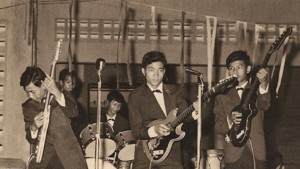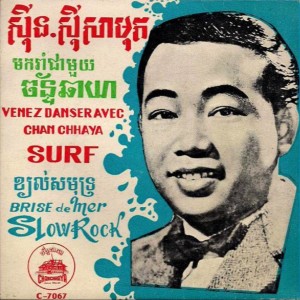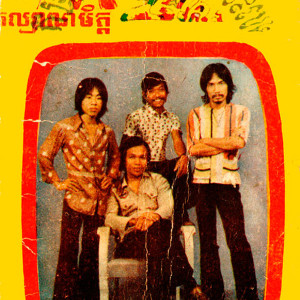 Review: Wisconsin Film Festival
Review: Wisconsin Film Festival
Don’t Think I’ve Forgotten: Cambodia’s Lost Rock and Roll | John Pirozzi | USA | 2014 | 105 min
Wisconsin Film Festival, Union South Marquee Theater, Sunday, April 12, 2:30pm»
Wisconsin Film Festival, Sundance Cinemas, Wednesday, April 15, 3:45pm»
In 1953, Cambodia declared its independence from French rule after nearly a century. The transition to a sovereign nation was a somewhat tumultuous one as Prince Norodom Sihanouk had to navigate between the Khmer Issarak, Viet Minh, Khmer Serei, and a host of other political groups. The French influence on Cambodian culture was undeniable as the music of Edith Piaf, Sylvie, and Johnny Hallyday could be heard on the radio waves. During this period, many of Cambodia’s young, hip crowds were clamoring to get their hands on as many Western recordings as they could.
From Go-Go, to Cha-Cha, and straight up garage rock, John Pirozzi’s Don’t Think I’ve Forgotten: Cambodia’s Lost Rock and Roll looks at the west’s influence on the booming Cambodian rock and roll scene in the 1960s and 1970s before the Khmer Rouge took power and decimated the country. This film does a great job capturing this little known gem of history.
Unfortunately, many Americans only associate Cambodia with the Khmer Rouge and the Vietnam War. At least 2,000,000 of Cambodia’s citizens were killed between 1975-1979. Many died from starvation as a result of the communist party’s policies, but many were tortured and killed. The film The Killing Fields (1984) serves as a chilling reminder of this bloody time in the history of Cambodia and Pol Pot’s rise to power. Sadly, the violence has overshadowed what was once a thriving music and cultural scene as Cambodia was once described as “the pearl of Southeast Asia”.

Excitement prevailed as the newly independent nation regained its sense of self and identity. Musical acts such as Sinn Sisamouth, Baksei Cham Krong, Drakkar, and Huoy Meas did not just mimic what they heard on the radio. Sinn Sisamouth is a bit of a cultural folk hero in Cambodia as he was wildly popular in the 50s and 60s. All modern Cambodian music can be traced back to him. These artists distinguished their sound by incorporating traditional themes and musical styles with their western counterparts, which created a unique cultural blend.

Fans of psychedelic and stoner rock will want to try and track down the Drakkar ’74 album. These four shaggy haired lads are similar to Strawberry Alarm Clock and Iron Butterfly. Their sound would have fit right in with some of the more popular psychedelic acts from Britain and the States circa 1967. As the band evolved, the Carlos Santana influence begun to emerge. The Latin influence mixed with the Cambodian vocal stylings created an interesting feel. Themes such as love and longing are prevalent in their music. Surprisingly, three of the bands members are still alive today. Their guitarist and bassist were never seen or heard from again once the Khmer Rouge was removed from power in 1979.
American GIs landed in Cambodia as the conflict in Vietnam began to escalate, and they brought with them the sounds of Wilson Pickett, the Beatles, and The Rolling Stones. Young women wore tight dresses and bobs reminiscent of the Supremes and young men strived to have the same swagger that was so emblematic of young American males in the 50s and 60s. Cambodian music, stylistically, often foregoes the metaphorical structure that many western songs use and relies on a more matter of fact, conversational tone. It is so interesting to see how this structure is used to tell the stories of the heartbreak that is soon to come once the Khmer Rouge takes it toll on Phnom Penh. Once the Khmer Rouge is in power, popular music is eradicated and replaced with the youth singing songs about the blood of the farmer and the workers while people starve to death en masse.
Part of the Khmer Rouge’s mission was to wipe out any indicators of western influence in the country. This meant killing singers, artists, and many city dwellers who had been touched by these influences. Many people had to lie about their backgrounds just in order to survive. Don’t Think I’ve Forgotten contains several clips and interviews with Cambodian citizens who were fortunate enough to survive this bloody period in their history. Several musicians who represented the heart and soul of their country were killed. In many cases what happened to the musicians and the loved ones of those interviewed remains unknown. Survivors know that their relatives were killed but some simply just disappeared without a trace. The idea of not having closure but only rumor and innuendo is beyond devastating.
I appreciated how Pirozzi couches this film from the perspective of the musicians and those who survived instead of focusing on the genocide itself. Naturally, the tragedy is an important story that must be told, but focusing on something beautiful that was taking place during so much hurt and pain should be front and center in this instance. Pirozzi brings this period of time to life with amazing detail.
One particularly moving story involves Ros Sereysothea and her relationship with Sinn Sisamouth. Standing at just five feet tall, she is a vocal powerhouse who is known as the Golden Voice of Cambodia. Ros, a beautiful young woman known for her charm as well as her vocals, marries a Cham singer by the name of Suos Mat. In addition to being married to two other women, Mat was insanely jealous of Ros’ success and attention she received from other men. One night, after a man in the audience flirts with her while she’s on stage, Mat flew into a jealous rage and beats her. She decided she had enough of the abuse and returns to her family in Battambang where she connects with Sinn Sisamouth and they record several duets together. Tragically, no one knows the circumstances of either of their deaths.
Don’t Think I’ve Forgotten serves as an important lesson of what happens when dark forces try to squeeze out the life and soul of a people, a soul that is often found in music. It is really a testament to resiliency and human triumph. Put together over the course of nine years using well over 150 interviews, this screening is not to be missed.